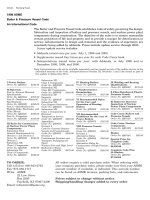Process Engineering Equipment Handbook Episode 2 Part 6 potx
Bạn đang xem bản rút gọn của tài liệu. Xem và tải ngay bản đầy đủ của tài liệu tại đây (1.46 MB, 50 trang )
G-14 Generators; Turbogenerators
FIG. G-11 Open cooling system. (Source: Alstom.)
FIG. G-12 Generator assembly. (Source: Alstom.)
Pilot exciter
The pilot exciter is a synchronous generator with permanent magnets on the rotor.
The rotor magnets are enclosed in a short-circuited aluminum ring that prevents
demagnetization of the poles because of short-circuiting in the stator winding.
The stator winding insulation satisfies the requirements for temperature class F
(155°C).
Exciter housing
Openings are provided in the side walls of the housing for cooling air intake and
exhaust and for service activities.
Support bearing
The support bearing consists of shield, bearing insulation, bearing, and shaft seals.
The bearing, which consists of a bearing body with white metal lining, is insulated
from the shield. The shaft seals against oil leakage from the bearing housing consist
of a split seal of oil-resistant insulation material. An air extractor is connected to
the bearing space to prevent oil leakage through the external seals. Internal shaft
seals are provided with sealing caps and the intermediate space is connected to the
blocking air from the pressure side of the fan.
Generators; Turbogenerators G-15
FIG. G-13 Main exciter. (Source: Alstom.)
Cooling
The exciter can be provided with either an open or a closed cooling system.
With an open cooling system, a housing with filter cassettes is mounted on one
side of the exciter housing for the incoming cooling air. The cooling air exit is
directed downward under the exciter housing.
With a closed cooling system, the filter housing is replaced with supply and
exhaust air channels connected to the cooler housing of the generator.
Surface Treatment
In its standard version, the generator is painted with a lacquer of two-component
type based on ethoxylized chlorine polymer. The generator is primed inside and
outside and then finished externally in a neutral blue color. The paint is resistant
to corrosive, tropical, and other aggressive atmospheres.
Static Excitation
When the rotor winding of the generator is supplied with current from a static
rectifier unit, the rotor is provided with a slipring shaft and supplied via brush gear.
Slipring shaft
The slipring shaft (see Figs. G-14 and G-15) consists of shaft extension, insulations,
sliprings, contact screws, and terminal conductors.
The shaft extension consists of a steel forging with flange for connection to the
shaft of the generator rotor. The center of the shaft extension is drilled for the
terminal conductors.
The sliprings are manufactured of steel and have generously dimensioned contact
surfaces for the carbon brushes. The spiral-machined contact surface is carefully
ground and polished. This prevents current concentrations and reduces brush and
slipring wear. The sliprings are shrunk on the shaft extension on a cylinder of
insulating material. The radial connections from the sliprings to the terminal
conductors consist of insulated contact screws through holes in the shaft extension.
The terminal conductors in the slipring shaft and the rotor shaft are connected
with contact screws.
Brush gear
The brush gear consists of a frame, insulation, brackets with brush holder, and
carbon brushes.
The brackets are insulated from the frame with rings of insulation material and
are connected to a supply ring to which cables for the excitation current are
connected. Each bracket is provided with a brush holder pocket for connection of a
handle to hold two carbon brushes.
The carbon brushes in the handle parts are mounted in holders of coil-spring type
that give a constant brush pressure during the service life of the brush. The handle
parts are insulated and the brush holders can be removed from the brush holder
pockets by hand when the brushes are to be replaced. Brush replacement is thus
possible during operations.
Slipring housing
Openings are formed in the side walls of the housing for service. These are covered
with hatches provided with air filters. The opening in the end wall of the housing,
G-16 Generators; Turbogenerators
towards the generator, through which the slipring shaft passes, is provided with a
seal.
Inspection and Testing
General basic inspection and testing points performed during the fabrication of the
generators are included in a check plan. Each manufacturing operation is subject
to extensive checking.
Final tests
Tests in accordance with Table G-1 constitute part of the normal testing before
delivery. A type test is performed on the first machine in a manufactured series and
Generators; Turbogenerators G-17
FIG. G-14 Slipring shaft end. (Source: Alstom.)
its result is used as a reference for the subsequent machines of the same type. A
more extensive test can be offered separately.
Control and Protection
Temperature monitoring
A number of platinum wire resistance elements installed in different parts of
the machine are used for continuous monitoring of the temperature of the parts.
The connection cables of the elements are routed to junction boxes on the outside
of the stator housing. The number and location of the elements are shown in the
following list:
G-18 Generators; Turbogenerators
FIG. G-15 Slipring assembly detail. (Source: Alstom.)
Number Location
6 In stator winding, between coil sides (2/phase)
2 Cooling air supply
2 Cooling air exhaust
1 Cooling air exhaust from exciter
As a standard, the resistance elements have a resistance of 100 ohms at 0°C.
Bearing vibration measurement
Vibration transducers of seismic type for bearing vibration measurement can be
delivered mounted on the bearing shields of the generator.
Heating elements
Heating elements are installed in both the generator and exciter unit to prevent
condensation during standstill of the generator at lower temperatures.
Current transformers
Current transformers can be mounted on the stator terminals outside the generator
casing. The transformers can be delivered in accordance with the purchaser’s
requirements.
Protective equipment
The original equipment manufacturer recommends that the generator, as a
minimum, be equipped with the following protective equipment:
Overcurrent protection
Overvoltage protection
Differential protection
Negative phase-sequence current protection
Stator earth fault protection
Rotor earth fault protection
Underexcitation protection and/or underexcitation limiter
Reverse power protection (depending on the drive machine type)
Generators; Turbogenerators G-19
TABLE
G-1 Normal Testing
Test Type Test Routine Test
Overspeed test ¥¥
Measurement of winding resistances ¥¥
Generator characteristics ¥
Measurement of generator losses (through run-down test) ¥
Bearing vibration measurement ¥
Loading point with cos j = 0 overexcited ¥
Heat run ¥
Measurement of the voltage curve form under no-load conditions ¥
Measurement of reactances ¥
Voltage test ¥¥
Measurement of insulation resistance ¥¥
Sound measurement ¥
Measurement of bearing insulation resistance ¥¥
Overexcitation and/or overexcitation limiter
Loss-of-excitation protection; in installations where there is a risk of high
overvoltages, a surge diverter is to be installed and, in certain cases, protective
capacitors
Operating Characteristics
Operations with constant winding temperature
With gas turbine operations, the principle described as follows is applied. This
provides an optimum relation between the permitted power output of the generator
and the power available from the turbine at varying cooling medium temperatures.
In accordance with international standards, particularly for gas turbine–powered
generators, the generator can be loaded so that the maximum winding temperature
permitted remains the same with a cooling air supply temperature other than
40°C. The winding temperature rises permitted increase or decrease as much as
the temperature of the cooling medium falls below, or exceeds, respectively, the
values given previously.
Synchronous compensator operation
The generators are particularly suitable for synchronous compensator operation. To
permit such operation, however, mechanical disconnection of turbine and generator
is usually required and one of the main bearings must be provided with thrust
bearings.
Operation at low ambient temperatures
With very low temperatures the generator can be provided with a recirculation
arrangement for cooling air or water.
Noise Reduction
When there are special acoustic requirements, the generator can be installed in a
sound-absorbing enclosure consisting of a steel frame with panels of perforated steel
sheets with sound-absorbing mineral wool in-fill.
The sealing against water leakage between the panels and the supporting
structure consists of a self-adhesive rubber strip and silicon-rubber caulking.
The roof and walls of the enclosure are provided with service openings.
Base frame
The stator frame of the generator is self-supporting and therefore requires no base
frame to provide stiffness. If the center height is required to be higher than
standard, the generator can be provided with a separate, welded, steel base frame.
Grinding (see Abrasives; Some Commonly Used Specifications, Codes, Standards,
and Texts)
Grinding Wheels (see Abrasives)
G-20 Grinding Wheels
H
Hazards (see Color Coding; Explosion; Some Commonly Used Specifications,
Codes, Standards, and Texts)
Heat Exchangers (see also Cogeneration; Regenerator; Vaporizers)
A heat exchanger basically removes or adds heat to a fluid. The most common types
in process plants are shell and tube exchangers. Plate types (consisting of heat-
conducting fins), cascade types (single pipe bent back and forth many times), and
spiral plate and extended surface types are less common. The working principle
behind the heat exchanger is well illustrated in the section on condensers (see
Condensers). A heat exchanger is usually custom designed for a large process plant
by the overall contract designer. Builders of items such as condensers and
separators generally also make related items such as heat exchangers and will have
a catalog on smaller items that can be bought without a custom order.
Some information on different commonly available heater types follows.
Heat Pumps; Heat Pumps, Geothermal; Heating Systems with
a Renewable Energy Source*
Working Theory behind Geothermal Heat Pumps
How earth loops work
A system of high-density polyethylene pipes is buried in the ground or installed in
a body of water to exchange heat between the building and earth. An antifreeze
solution is circulated through the pipes by low wattage pumps. The plastic pipe wall
becomes a heat exchanger between the fluid and the surrounding earth. In the
heating mode the liquid in the pipe is cooler than the surrounding earth. In the
cooling mode the opposite condition exists. Since heat flows from a warm area to a
cooler one, heat exchange occurs under both conditions.
Pond and lake loops
Short polyethylene loop coils are stretched horizontally and attached to a plastic
mesh to form a mat-style anchored heat exchanger. Several mats are connected
together, and once in position the pipes are filled with fluid, possibly weighted, and
the mats sink to the bottom. See Fig. H-1.
Open loops (well systems)
In areas where a good supply of clean ground water and an accessible water
discharge system is available, an earth loop becomes unnecessary. Well water is
pumped directly through the unit and heat is either extracted from or rejected back
to the water table. See Fig. H-2.
H-1
* Source: Enertran, Canada. Adapted with permission.
Earth loop configurations
Earth loops (Figs. H-3 and H-4) are installed in either horizontal or vertical
configurations; the choice depends upon geographical location and the land area
available. [This information source’s systems are sized to meet or exceed CSA
Standard—M445 (sizing requirements), fulfilling the stringent energy efficiency
requirements of the North American Building Codes.] Earth loop lengths are
calculated using a sophisticated computer program that predicts annual loop
performance, energy consumption, and operating costs.
Horizontal loops. Horizontal loop designs vary from a single, in-series pipe to
multipipe parallel systems. Pipes are laid in trenches 4–6 ft deep, using a backhoe
or trencher, and pressure tested, and then the trench is backfilled. See Fig. H-3.
Vertical loops. Vertical loops usually require less pipe than horizontal
configurations. Vertical loops are connected in series or parallel or both. Drilling
equipment produces small diameter holes, 75 to 300 ft deep. Two pipes are joined
H-2 Heat Pumps; Heat Pumps, Geothermal; Heating Systems with a Renewable Energy Source
FIG. H-1 Pond and lake loops. (Source: Enertran.)
FIG. H-2 Open loops (well systems). (Source: Enertran.)
with a U-bend and are inserted into each hole. Once inserted, the pipes are pressure
tested and the bore hole is backfilled. See Fig. H-4.
Liquid-to-liquid systems
Hot and cool water is forced through, or to, a hydronic transfer system, such as
radiators, in-floor heating, air handlers, convectors, and fan coils.
Liquid-to-air systems
Hot and cool air is forced through an air ductwork system. Most OEMs also offer
both “liquid to air” and “liquid to liquid” in one unitary system.
Partial hot water (PHW) heating
The PHW heating option transfers excess heat produced by the unit into any
domestic hot water tank, whenever the system is operating. Savings of up to 65
percent per year are possible with PHW.
Heat Pumps; Heat Pumps, Geothermal; Heating Systems with a Renewable Energy Source H-3
FIG. H-4 Vertical loops. (Source: Enertran.)
FIG. H-3 Horizontal loops. (Source: Enertran.)
On-demand hot water (ODHW) heating
This heating option transfers heat into hot water on demand, at any time it is
required. ODHW is suitable for heating swimming pools and spas, or in-floor
heating in combination with a forced air heating and cooling system.
Liquid-cooled air conditioning
Operating at approximately 50 percent less than the cost of traditional air
conditioners, including very low flow rates (1 US GPM per ton), liquid-cooled air
conditioners can transfer heat from a building into a liquid heat sink—such as
domestic hot water, swimming pools, commercial laundries, ground water, or an
earth loop. They can be retrofitted to most central forced air systems, or used for
spot-cooling in difficult applications. All components are installed inside the
building, reducing maintenance service cost and installation cost. Liquid-cooled air
conditioning systems eliminate the need for potentially noisy outdoor condensers.
See Fig. H-5.
High humidity conditions
Excessive humidity can cause major structural damage if left unattended for long
periods of time. High humidity also accelerates the growth of mold, bacteria, and
viruses. Indoor swimming pools, spas, and commercial operations such as indoor
ice rinks and underground pumping stations, all depend on good humidity control.
In a situation where dehumidification is needed and heat is needed in other
areas, various heat transfer methods, including dehumidification, as well as
simultaneously transferring the process heat to water/air, can be used.
Mechanical dehumidification systems
Dramatic savings on the energy cost of dehumidification, compared to conventional
air makeup systems is possible. Moist air drawn through the system is cooled below
its dew point, drawing moisture from the air. Heat captured by the system is
H-4 Heat Pumps; Heat Pumps, Geothermal; Heating Systems with a Renewable Energy Source
FIG. H-5
Operating cost comparison (reflects heating costs only). (Source: Enertran.)
recycled back to the pool enclosure as warm dry air or back into the pool as warm
water. Constant positive humidity control ensures comfortable conditions at all
times. These mechanical dehumidification systems can be easily integrated with a
geothermal system and other products, including liquid-cooled air conditioning, to
provide economical air conditioning.
Hybrid systems
Hybrid systems combine the highest efficiency, liquid cooled air conditioning with
an integrated hot water heated, forced air delivery system in one package. Heat
source options can be a hot water heating system, tanks, liquid to liquid heat
pumps, etc. Cooling options are identical to those used for liquid cooled air
conditioners. (See Figs. H-6 through H-8.)
Reference and Additional Reading
1. Soares, C. M., Environmental Technology and Economics: Sustainable Development in Industry,
Butterworth-Heinemann, 1999.
Heat Pumps; Heat Pumps, Geothermal; Heating Systems with a Renewable Energy Source H-5
FIG. H-6 Cooling position. (Source: Enertran.)
FIG. H-7 Heating position. (Source: Enertran.)
Heat Treatment (see Metallurgy)
Heaters, Electric*
Impedance-Type Electric Heaters
The advantages of impedance heaters (see Fig. H-9) are as follows:
1. Low life-cycle costs
2. Low maintenance cost
3. Long operating life
4. Simple operating cycle
5. Easy to clean—easy access
H-6 Heat Treatment
FIG
. H-8 Heat reclaim options/opportunities. (Source: Enertran.)
FIG
. H-9 Impedance-type electric heaters. (Source: Armstrong Engineering Associates.)
* Source: Armstrong Engineering Associates, USA. Adapted with permission.
Heaters, Electric H-7
6. Available in most metals
7. Close and precise temperature control
8. Ideal for heating acids, other corrosive fluids
9. Just the tube is needed—no shell is required
10. High electrical flux density is possible
11. Handles 2-phase mixtures, liquids and solids mixed
12. Suitable for high-temperature (2000°F/1093°C), low-temperature (-325°F/
-198°C), and high-pressure (up to 5000 psi/352 kg/cm
2
) operating parameters
13. Heaters operate at very low voltages so there is no safety issue
14. Flow pipes carry the current and heat the fluid passing through directly
15. Less corrosion due to thicker tubes for same exit temperature of fluid
16. Accurate heat transfer data (in tube flow) allows accurate heater design
How impedance heating works
Electrical connections are secured to each end of the pipe through which the fluids
flow. Refer to Fig. H-10 for the location of electric terminals on a common single-
FIG. H-10 Typical impedance heater. 180 kW heating air to 1500°F (816°C) in a U.S. chemical plant.
(Source: Armstrong Engineering Associates.)
phase connected arrangement. The pipe’s electrical resistance causes the pipe to
heat up and impart heat to the fluid flowing inside the pipe. Voltages used for
this application are typically relatively low (50 V or below). See Figs. H-10 through
H-12.
Heat transfer/pressure drop in impedance heaters
Since the tube wall is hot and the flow is through normal tubes or pipes, the heat
transfer is easily calculated by engineers using experience in design and rating of
chemical plant miscellaneous chemical fluids.
In Fig. H-12, the heater is heating air from atmospheric intake to over 1850°F
(1010°C) exit temperature.
“Electrofin” Heaters
This information source has designed a specific model of heater trademarked
“Electrofin.” It is a compact design with the following features:
1. Up to 40 kW per single tube in a 20-ft-long (6-m) unit and more surface per tube
often results in smaller shell diameter (lower cost)
2. Available in most metals including steel, stainlesses, nickel, Monel, Inconel,
Incoloy, Hastelloy, etc.
3. Single tube or multiple tube combinations; lengths to 20 ft (6 m)
4. Accompanying control panels available with thyristor or contactor designs
5. Design pressures available up to 6000 psi (442 kg/cm
2
)
6. Fluid temperatures available -292°F to +1202°F (-180°C to +650°F)
7. Suitable for most liquids and gases including high viscosities
H-8 Heaters, Electric
FIG. H-11 Single-phase, straight tube impedance heater. (Source: Armstrong Engineering
Associates.)
See Figs. H-13 through H-19.
“Electrofin” tank heaters (see Fig. H-20) have an attached thermocouple allowing
monitoring of the heating element that can be connected to a relay in the control
to allow the unit to be shut down if the internal heater overheats due to debris,
fouling, etc.
Fintube tank heaters can also use steam or other normal heating fluids.
Heaters, Electric H-9
FIG. H-12 Pilot impedance heater in Romansville plant heats air to 1850°F (1010°C). (Source:
Armstrong Engineering Associates.)
FIG. H-13 24-in-diameter (610-mm) multitube Electrofin heater operating in African chemical plant.
(Source: Armstrong Engineering Associates.)
H-10 Heaters, Electric
FIG
. H-14 Two types of single tube heater. (Source: Armstrong Engineering Associates.)
FIG. H-15 Multitube longitudinal fin tube-type heater. (Source: Armstrong Engineering Associates.)
FIG. H-16 Three-stage single tube Inconel heater for heating viscous organic fluid. (Source:
Armstrong Engineering Associates.)
Heaters, Electric H-11
FIG. H-17 Twin single tube vapor heaters of stainless steel type 304 construction heating ethyl
ether from 392°F (200°C) to 842°F (450°C). (Source: Armstrong Engineering Associates.)
FIG. H-18 Heavy-duty electrical resistance heating elements with welded fins. (Source: Armstrong Engineering Associates.)
FIG. H-19 Robust thick fins are continuously welded to the electrical heating element. (Source: Armstrong Engineering
Associates.)
Electric Hot Pipe Tank Heaters
This is a heavy robust heater type, strong enough for very high viscosity fluids.
Features include:
1. Fins are welded to pipe. Strong contact (between fins and pipe) does not
deteriorate with cycling over time as compared to wrapped or unwelded thin fins,
which lose heat transfer due to rising contact resistance. The heaters do not lose
capacity with age. Fins are 1.5-mm thick. Liberal fin surface gives low watt
density on heating surface.
2. Fins are strong enough to allow high pressure hose cleaning and user walking
on heaters.
3. Electric heaters are not subject to condensate freeze-up in the event of low
temperatures.
4. Heaters may be supplied to hold temperatures from cryogenic levels up to
1200°F (650°C).
5. High turndown capacity possible due to electric heat control. Not limited by
steam condensing at a minimum of 212°F (100°C).
6. Relatively simple control available.
7. Internal electric heating elements can be withdrawn from the tank without
draining the tank while the outer fintube remains in the tank.
8. Available in various metals: steel, stainless steels, Monel, Inconel, Incoloy, nickel,
Hastelloy, silicon bronze, etc.
9. Heaters can be supplied in long lengths. Also with bare heating pipes (no fins)
if preferred.
Tank Heater Types (Steam or Electric Heated)
See Figs. H-21 through H-26.
H-12 Heaters, Electric
FIG. H-20 Shop photograph of CSA-approved electric hot pipe tank heaters showing terminal
boxes of explosion-proof Ex(d) design. Serrated fin tube outer pipes. The internal heating elements
are removable without draining tank. (Source: Armstrong Engineering Associates.)
FIG. H-21 Suction-type heater, normally installed in tank side nozzle, to heat up relatively larger
flows of viscous materials using steam, hot water, or other heating fluid in the tubes. These
heaters normally have low shell side pressure drops to minimize npsh problems on pumps. For
very high viscosity fluids, consult the manufacturer for methods of reducing intake viscosity. An
internal shutoff valve can be used to allow easy bundle removal. Main uses of this type heater
include bunker C, fuel oils, asphalt, molasses, caustic, etc. (Source: Armstrong Engineering
Associates.)
FIG. H-22 Line-type heater. This is simply a suction-type heater with an enclosed end so that the
heater can be installed outside the tank. This permits addition of an external valve between the
tank and the heater to allow servicing of the heater without pumping down the tank. Basically, the
incentive to use a line heater is either maintenance ease or piping simplicity. (Source: Armstrong
Engineering Associates.)
H-13
FIG. H-23 Bayonet-type stab-in tank heater. For installation in side entering tank nozzle. Bayonet
heaters are usually single pipe, with fins to allow good natural convection circulation of the fluid
being heated. These heaters are available in a multiplicity of metals, including the stainless steels.
(Source: Armstrong Engineering Associates.)
H-14
FIG. H-24 Coil-type stab-in tank heater. This type heater is installed through a side entering tank
nozzle, and differs from the bayonet type in that usually more pipes or tubes than one are used,
requiring therefore a tubesheet and bonnet, or a continuous coil to allow for usually lower flow of
heating medium such as heat transfer oils, diphenyl, etc. Fins are helical for natural convection.
(Source: Armstrong Engineering Associates.)
FIG. H-25 Vertical cluster “in tank” heater. This type of heater can be supplied in many metals but
is usually steel or stainless steel, is used to give very large amounts of surface in a relatively
confined space. These heaters can be either steam or heat transfer oil heated. Very high viscosity
fluid application: By placing several such heaters around the intake of a suction heater, the fluid
viscosity can be reduced sufficiently to allow the normally highly viscous fluids to enter the
suction heater intake, where otherwise they might not flow well enough to ensure normal operation
of the suction heaters. (Source: Armstrong Engineering Associates.)
FIG
. H-26 Horizontal “in tank” heater. This type heater has fins to allow good thermosiphon
circulation of the fluid being heated, and gives a wide thermal current stimulation. Due to the
compact surface, much larger amounts of heat can be added to the tank contents than when using
bare tube coils of comparable area. (Source: Armstrong Engineering Associates.)
Sheathed Element Electric Process Heaters
Design pressures available depend somewhat on bundle diameter but bundles
up to 10 in (254 mm) are available to very high design pressures [up to 10,000 psi
(703 kg/cm
2
)]. Heaters are supplied to various codes (ASME, Stoomwezen, most
European, and also Lloyds, etc.). See Figs. H-27 through H-31.
Design temperatures of this unit are available from cryogenic levels up to about
1250°F (677°C) design operating temperature.
Most sizes are CSA and BASEEFA approved as well as Australian Code approved.
Typical shell diameters run from 1.5 in (38.1 mm) OD up to and including 48 in
(1220 mm) OD.
Shells and pressure parts are available fabricated of most pressure vessel
materials (steel, stainlesses, nickel, Monel, Hastelloy, Inconel, Incoloy, etc.).
Design voltages include 600 volts and higher.
Connections for sheathed element electric process resistance heaters as well as
circuit equations are in Fig. H-32.
Heaters, Electric H-15
FIG. H-27 Process-type heaters are available from 2 in (51 mm) to 48 in (1219 mm) shell diameter.
Unit is 42 in (1066 mm) shell diameter. (Source: Armstrong Engineering Associates.)
FIG. H-28 Bottom bundles are sheathed element heater. Liquid level of intermediate fluid is boiled
by bottom bundle and then condenses on top bundle. Intermediate unit is used when pressure is
very high or upper heating bundle is of very costly metal to avoid having the whole unit of the
costly metal or the high pressure design, which is thus confined only to the upper bundle. (Source:
Armstrong Engineering Associates.)
Controls for Electric Heaters
Controls are thyristor type or contactor type with many variations. Panels are
pretested where numerous tests, such as heat rise under load, confirmation of
control functions, RF emissions, waveform photography, etc. as may be required,
are conducted.
H-16 Heaters, Electric
FIG. H-29 Large radiant furnace used to heat either fluidized bed vessel or to heat high pressure,
high alloy, or high temperature fluid containing coils. (Source: Armstrong Engineering Associates.)
FIG. H-30 Stainless steel reboiler for mixed organic acids. (Source: Armstrong Engineering
Associates.)
Special attention is given to heat rejection facilities for tropic or warm zone
operations to ensure control elements are not overheated. In some cases, air
conditioners may be attached to panels to keep cooling close to 122°F (50°C).
Features of explosion-proof control panels
The panel shell (see Figs. H-33 and H-34) must be heavily built and capable of
withstanding, without damage, an explosion inside the box due to combined process
fluid and air and must not cause failure or damage to the containment vessel.
Heaters, Electric H-17
FIG
. H-31 Indirect fluid electric vaporizer with controls mounted. High pressure heater of corrosive
fluid. Fluid side 3175 psi (223 kg/cm
2
) design pressure. (Source: Armstrong Engineering
Associates.)
FIG. H-32 Circuitry of sheathed element electric process resistance heaters. (Source: Armstrong Engineering Associates.)









